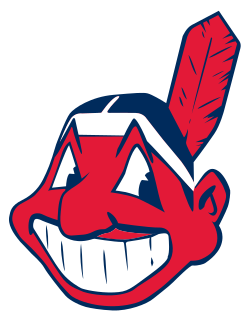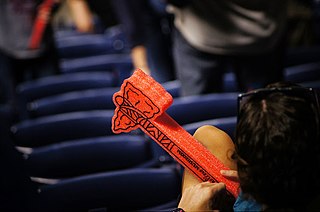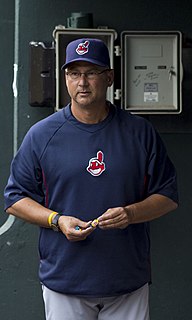
The Cleveland Guardians are an American professional baseball team based in Cleveland. The Guardians compete in Major League Baseball (MLB) as a member club of the American League (AL) Central division. Since 1994, they have played at Progressive Field. Since their establishment as a Major League franchise in 1901, the team has won 10 Central division titles, six American League pennants, and two World Series championships,. The team's World Series championship drought since 1948 is the longest active among all 30 current Major League teams. The team's name references the Guardians of Traffic, eight monolithic 1932 Art Deco sculptures by Henry Hering on the city's Hope Memorial Bridge, which is adjacent to Progressive Field. The team's mascot is named "Slider." The team's spring training facility is at Goodyear Ballpark in Goodyear, Arizona.

The American Indian Movement (AIM) is a Native American grassroots movement founded in July 1968 in Minneapolis, Minnesota, initially centered in urban areas to address systemic issues of poverty, discrimination, and police brutality against Native Americans. AIM soon widened its focus from urban issues to include many Indigenous Tribal issues that Native American groups have faced due to settler colonialism of the Americas. These have included treaty rights, high rates of unemployment, Native American education, cultural continuity, and preservation of Indigenous cultures.

Chief Illiniwek was the mascot of the University of Illinois Urbana–Champaign (UIUC), associated with the University's intercollegiate athletic programs, from October 30, 1926 to February 21, 2007. Chief Illiniwek was portrayed by a student to represent the Illiniwek, the state's namesake, although the regalia worn was from the Sioux. The student portraying Chief Illiniwek performed during halftime of Illinois football and basketball games, as well as during women's volleyball matches.
Chief Moccanooga was the former athletic mascot for the University of Tennessee at Chattanooga, until 1996, when the university abandoned the mascot as potentially offensive at the request of the Chattanooga InterTribal Association. Chief Moccanooga was replaced with a mockingbird, the state bird of Tennessee, and the nickname for Chattanooga athletics was changed from 'Moccasins' to simply 'Mocs'.

Charlene Teters is a Native American artist, educator, and lecturer. Her paintings and art installations have been featured in over 21 major exhibitions, commissions, and collections. She is a member of the Spokane Tribe, and her Spokane name is Slum Tah. She was born and raised in Spokane, Washington, near the Spokane Indian Reservation.

Chief Wahoo was a logo used by the Cleveland Indians, a Major League Baseball (MLB) franchise based in Cleveland, Ohio, from 1951 to 2018.

Since the 1960s, the issue of Native American and First Nations names and images being used by sports teams as mascots has been the subject of increasing public controversy in the United States and Canada. This has been a period of rising Indigenous civil rights movements, and Native Americans and their supporters object to the use of images and names in a manner and context they consider derogatory. They have conducted numerous protests and tried to educate the public on this issue.

Vernon Bellecourt (WaBun-Inini) was a member of the White Earth Band of Ojibwe, a Native American rights activist, and a leader in the American Indian Movement (AIM). In the Ojibwe language, his name meant "Man of Dawn."
Elmer Woggon, who signed his art Wog, was the creator of an early newspaper comic strip that eventually developed into the long-running Steve Roper and Mike Nomad.

The Washington Redskins name controversy involved the name and logo previously used by the Washington Commanders, a National Football League (NFL) franchise located in the Washington metropolitan area. In the 1960s, the team's longtime name—the Redskins—and the associated logo began to draw criticism from Native American groups and individuals. The topic, part of the larger Native American mascot controversy, began receiving widespread public attention in the 1990s. In 2020, the team responded to economic pressure in the wake of widespread recognition of systemic racism by retiring the name and logo. The team called itself the "Washington Football Team" before rebranding as the Commanders in 2022.
Jacqueline Keeler is a Native American writer and activist, enrolled in the Navajo Nation and of Yankton Dakota descent, who co-founded Eradicating Offensive Native Mascotry (EONM), which seeks to end the use of Native American racial groups as mascots.
Sundance is an American Indian civil rights activist. He is perhaps best known for being one of several prominent American Indians to spearhead the movement against the use of Native American imagery as sports mascots.
Philip Yenyo is a Native American civil rights activist. He is one of several prominent activists to spearhead the movement against the use of Native American imagery as sports mascots.
Sports teams named Redskins are part of the larger controversy regarding the use of Native American names, images and symbols by non-native sports teams. Teams of this name have received particular public attention because the term redskin is now generally regarded as disparaging and offensive.

The Cleveland Indians name and logo controversy referred to the controversy surrounding the club name and logo previously used by Major League Baseball's Cleveland Guardians, an American professional baseball team based in Cleveland, Ohio.
The use of terms and images referring to Native Americans/First Nations as the name or mascot for a sports team is a topic of public controversy in the United States and in Canada, arising as part of the Native American/First Nations civil rights movements. Since the 1960s, there have been a number of protests and other actions by Native Americans and others targeting the more prominent use of such names and images by professional franchises such as the Cleveland Indians and the Washington Redskins. However, discourse surrounding mascot usage by elementary, middle, and high schools has been prominent, as these entities are subject to public legislation and community input.

The Chicago Blackhawks name and logo controversy refers to the controversy surrounding the name and logo of the Chicago Blackhawks, a National Hockey League (NHL) ice hockey team based in Chicago, Illinois. The use of terms and images referring to Native Americans/First Nations as the name or mascot for a sports team without permissions from or consultations with local Indigenous communities, is a topic of public controversy in the United States and Canada. Since the 1960s, as part of the indigenous civil rights movements, there have been a number of protests and other actions by Native Americans and their supporters targeting the more prominent use of such names and images by professional franchises such as the Cleveland Guardians formerly known as the "Indians" of Major League Baseball (MLB) that was officially discontinued in 2016; the Washington Commanders formerly known as the "Redskins" of the National Football League (NFL), the NFL's Kansas City Chiefs and MLB's Atlanta Braves, the latter two attracting criticism of "the tomahawk chop" often performed by their fans. Like other teams with tribal mascots, there are calls from Indigenous activists and organizations to change the Blackhawks' name and logo and eliminate tribal mascots and imagery throughout sports.

The 2018 Cleveland Indians season was the 118th season for the franchise. It was the sixth season under the leadership of manager Terry Francona and third under general manager Mike Chernoff. The Indians played all of their home games at Progressive Field in Cleveland, Ohio. This was the last season in which the Indians logo Chief Wahoo was used on uniforms or on stadium signs. They won their third straight American League Central title before being swept by the defending World Series champion Houston Astros in the 2018 American League Division Series. Due to the Indians losing to the Astros, the Indians became the 5th team in MLB history to have a 70 year title drought.
Indigenous activists in Cleveland, Ohio, have advocated Indigenous issues and rights since the early 1900s. After the removal of the last American Indians from their traditional territory in Ohio in 1842, Cleveland, and the greater Cuyahoga County, had an almost nonexistent Indigenous population. However, in the early 1900s, an Osaukee man named Chief Thunderwater engaged in activism, protesting the displacement of the Erie Street Cemetery and creating the Supreme Council of Indian Nations, which advocated for Indigenous peoples' right to cross the United States–Canada border in the Supreme Court Case, McCandless v. United States. Later in the century, the Indian Relocation Act of 1956 moved a variety of Native Americans from their different reservations in the West into Ohio, specifically metropolitan areas like Cleveland. With the resurgent population came a wave of activism, as the Cleveland American Indian center was created and the national American Indian Movement established a chapter in the city in 1970. Annual mascot protests in Cleveland began in 1972, with local groups AIM and the Committee of 500 Years of Dignity and Resistance participating. An important Ohio Supreme Court case, Bellecourt v. City of Cleveland, protected protestors first amendment rights in court. The Cleveland Indians ended the use of their old mascot, Chief Wahoo, in 2019 and in 2020 announced that they would consider changing their team name, in response to ongoing protests. In July 2021, the Cleveland baseball team announced their new name: The Cleveland Guardians. Mascot protests also extend to local schools in the Cleveland area, where the Oberlin School District ended their use of Indians as their mascot.










